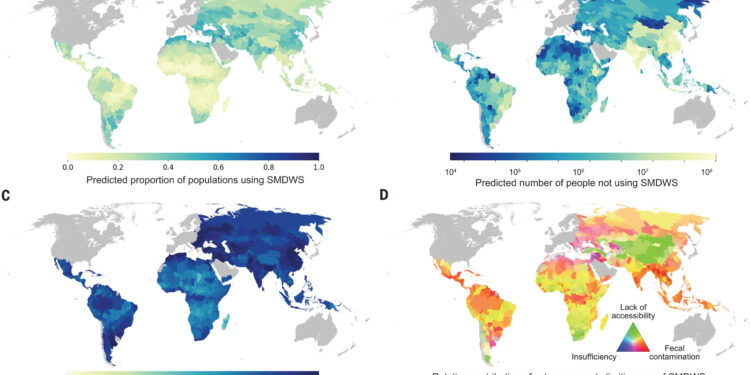Mapping the use of safely managed drinking water services. (A) number of users (B); percentage of people using an improved drinking water source; (C) map showing faecal contamination (red), lack of accessibility (green) and insufficiency (blue); (D) global administrative area level 1 in LMICS. Credit: Science (2024). DOI: 10.1126/science.adh9578
A multi-institutional team of environmental scientists has conducted a computer simulation showing that more than half of the world’s population has limited access to clean drinking water. The results are published in the journal Science.
Rob Hope of the University of Oxford has published a Perspective paper in the same issue of the journal outlining the conditions that must be met for an area or region to be classified as having safe drinking water and describing the work the team is doing on this new effort.
In 2020, organizations around the world estimated that about 2 billion people worldwide lacked access to safe drinking water. In this new study, researchers found evidence that this number is actually more than double.
As Hope points out, access to clean water means that people have access to safe water on demand, whenever they need it. Access to clean water also means that water is available on site – people shouldn’t have to travel to find it. And the water they drink should be free of bacteria or harmful chemicals.
The researchers built their simulation using environmental data and surveys of nearly 65,000 households around the world. The team used the simulation to generate maps of 135 countries showing where people had access to clean water.
They then compared the maps with UNICEF data to calculate an estimate of the total number of people in the world who lack access to clean water. They found that the number is 4.4 billion, or more than half of the world’s current population of 8 billion.
As expected, the research team found that most people without access to safe drinking water lived in South Asia, sub-Saharan Africa, and East Asia. They also found that the main barriers to accessing safe drinking water were the presence of contaminants and lack of infrastructure. For example, they noted that about 650 million people in parts of Africa live in places where there is no water service.
More information:
Esther E. Greenwood et al., Mapping drinking water use in low- and middle-income countries, Science (2024). DOI: 10.1126/science.adh9578
Rob Hope, Four billion people lack access to clean water, Science (2024). DOI: 10.1126/science.adr3271
© 2024 Science X Network
Quote:Computer simulations suggest that more than half of people on Earth have limited access to clean drinking water (2024, August 16) retrieved August 16, 2024 from
This document is subject to copyright. Apart from any fair dealing for the purpose of private study or research, no part may be reproduced without written permission. The content is provided for informational purposes only.



